
JUST THE FACTS
(as they have been made public through the media)
- Dolly, a Finn Dorset sheep, was born on July 5, 1996 at Roslin Institute, a research center located near Edinburgh, Scotland
- Dolly was the first mammal known to be cloned from an adult of the species. In this case, a cell taken from the mammary gland of a 6 year old Finn Dorset ewe was cloned through a technique known as nuclear transfer.
- The cloning process began with the extraction of 277 separate mammary cells from a Finn Dorset ewe. These cells were "starved" for five days in the lab so that they would go into a suspended or quiescent state. This was necessary so that their "identity" as mammary cells would be turned off and the DNA susceptible to reprogramming once they were fused with egg cells.
- Simultaneously, oocytes or reproductive egg cells were removed from another female sheep, (in this case, a ewe of a different and easily distinguishable breed, a Scottish Blackface).
- The nucleus from each of those oocytes was extracted in the lab. It is the nucleus that contains the genetic material that would normally determine the characteristics of the offspring. These unfertilized and genetically empty Scottish Blackface egg cells were then ready to be "fertilized" with the genetic material from the Finn Dorset mammary cells.
- Next, the 277 enucleated egg cells were fused with genetic material from the mammary cells.
- Electric current was applied to the eggs to simulate the burst of energy that occurs during normal fertilization and to begin embryonic develpment.
- Of the 277 fused egg cells only 29 embryos survived. Of these 29, only 13 were successfully implanted in the wombs of Blackface ewes.
- 148 days after fusion, i.e., laboratory fertilization, on July 5, 1996, Dolly was born from one of the surrogate Blackface ewes--the single successful outcome of 277 attempts to clone.
- The story of Dolly's birth as the first clone of an adult mammal was released to the public the following February when Dolly was a little more than 6 months old.
|
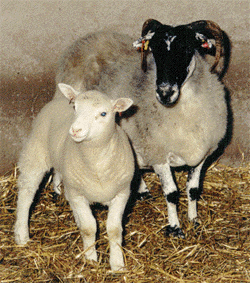
Dolly, the Finn Dorset lamb in 1996 and her surrogate Scottish Blackface mother
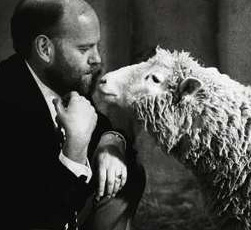
Dr. Ian Wilmut and Dolly [Cover of Time Magazine: DECEMBER 29, 1997/JANUARY 5, 1998. VOL.150 NO.28]
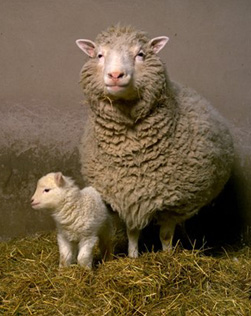
Dolly and her first lamb, Bonnie, born April 13th, 1998, and fathered naturally by David, a Welsh Mountain ram.
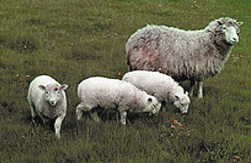
Dolly and her three lambs--two males and one female--born March 24th, 1999. David, the father of Bonnie, also sired these triplets.
[Images used here available to the public through the Roslin Institute website unless labeled otherwise]
|

SOURCE MATERIAL
http://www.time.com/time/cloning/dolly.html
Dolly an Unsettling Breakthrough
http://www.time.com/time/moy/runnerwilmut.html"
Dr. Ian Wilmut, Time's Man of the Year
http://www.newscientist.com/hottopics/cloning/
cloning.jsp?id=20710200
One small step for a sheep...From NewScientist.com
http://www.accessexcellence.org/WN/SUA09/
clone297.html
Send in the Clones: Science Update from Access Excellence at the National Health Museum
http://www.newscientist.com/hottopics/cloning/
cloning.jsp?id=22020300
Dolly's Mixture
http://www.roslin.ac.uk/
Roslin Institute, Midlothian Scotland
The Road to Dolly and the Path Ahead: Clone by Gina Kolata New York: William Morrow and Company, 1998)
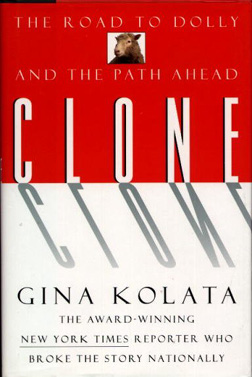
Cloning:
The Laboratory Process
Diversity:
How Cloning and Genetic Engineering Affect the Diversity of Breeds and
Species
Sheep
Symbolism, Shepherds, and Sacrificial Lambs |






